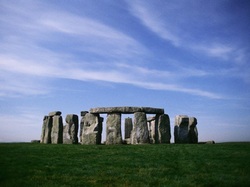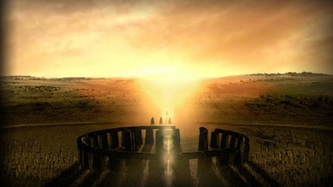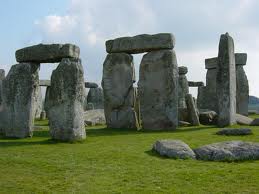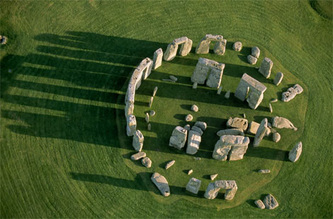Stonehenge

The first Stonehenge was a large earthwork or Henge, comprising a ditch, bank, and the Aubrey holes, all built around 3100 BC. The Aubrey holes are round pits in the chalk, about one metre wide and deep, with steep sides and flat bottoms. They form a circle about 284 feet in diameter. Excavations have revealed cremated human bones in some of the chalk filling, but the holes themselves were probably made, not for the purpose of graves, but as part of the religious ceremony. Shortly after this stage Stonehenge was abandoned, left untouched for over 1000 years.
The most dramatic stage of Stonehenge started around 2150 BC. Some 82 bluestones from the Preseli mountains, in south-west Wales were transported to the site. It is thought these stones, some weighing 4 tonnes each were dragged on rollers and sledges to the headwaters on Milford Haven and then loaded onto rafts. They were carried by water along the south coast of Wales and up the rivers Avon and Frome, before being dragged overland again to near Warminster in Wiltshire. The final stage of the journey was mainly by water, down the river Wylye to Salisbury, then the Salisbury Avon to west Amesbury. This astonishing journey covers nearly 240 miles. Once at the site, these stones were set up in the centre to form an incomplete double circle.
The third stage of Stonehenge, about 2000 BC, saw the arrival of the Sarsen stones, which were almost certainly brought from the Marlborough Downs near Avebury, in north Wiltshire, about 25 miles north of Stonehenge. The largest Sarsen stone was transported to Stonehenge weigh 50 tonnes and transportation by water would have been impossible, the stones could only have been moved using sledges and ropes. Modern calculations show that it would have taken 500 men using leather ropes to pull one stone, with an extra 100 men needed to lay the huge rollers in front of the sledge.
These were arranged in an outer circle with a continuous run of lintels. Inside the circle, five trilithons were placed in a horseshoe arrangement, whose remains we can still see today.
The final stage took place soon after 1500 BC when the bluestones were rearranged in the horseshoe and circle that we see today. The original number of stones in the bluestone circle was probably around 60, these have long since been removed or broken up. Some remain only as stumps below ground level.
The most dramatic stage of Stonehenge started around 2150 BC. Some 82 bluestones from the Preseli mountains, in south-west Wales were transported to the site. It is thought these stones, some weighing 4 tonnes each were dragged on rollers and sledges to the headwaters on Milford Haven and then loaded onto rafts. They were carried by water along the south coast of Wales and up the rivers Avon and Frome, before being dragged overland again to near Warminster in Wiltshire. The final stage of the journey was mainly by water, down the river Wylye to Salisbury, then the Salisbury Avon to west Amesbury. This astonishing journey covers nearly 240 miles. Once at the site, these stones were set up in the centre to form an incomplete double circle.
The third stage of Stonehenge, about 2000 BC, saw the arrival of the Sarsen stones, which were almost certainly brought from the Marlborough Downs near Avebury, in north Wiltshire, about 25 miles north of Stonehenge. The largest Sarsen stone was transported to Stonehenge weigh 50 tonnes and transportation by water would have been impossible, the stones could only have been moved using sledges and ropes. Modern calculations show that it would have taken 500 men using leather ropes to pull one stone, with an extra 100 men needed to lay the huge rollers in front of the sledge.
These were arranged in an outer circle with a continuous run of lintels. Inside the circle, five trilithons were placed in a horseshoe arrangement, whose remains we can still see today.
The final stage took place soon after 1500 BC when the bluestones were rearranged in the horseshoe and circle that we see today. The original number of stones in the bluestone circle was probably around 60, these have long since been removed or broken up. Some remain only as stumps below ground level.





